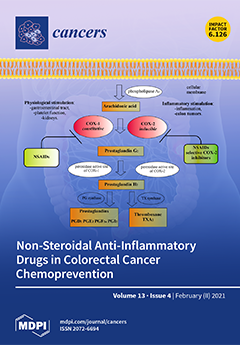Open AccessArticle
Germline and Somatic Whole-Exome Sequencing Identifies New Candidate Genes Involved in Familial Predisposition to Serrated Polyposis Syndrome
by
Yasmin Soares de Lima, Coral Arnau-Collell, Marcos Díaz-Gay, Laia Bonjoch, Sebastià Franch-Expósito, Jenifer Muñoz, Leticia Moreira, Teresa Ocaña, Miriam Cuatrecasas, Cristina Herrera-Pariente, Sabela Carballal, Lorena Moreno, Aránzazu Díaz de Bustamante, Antoni Castells, Luis Bujanda, Joaquín Cubiella, Daniel Rodríguez-Alcalde, Francesc Balaguer and Sergi Castellví-Bel
Cited by 18 | Viewed by 5594
Abstract
The serrated polyposis syndrome (SPS) is the most common and yet underdiagnosed colorectal polyposis syndrome. It is characterized by multiple and/or large colonic serrated polyps and a higher associated risk for colorectal cancer (CRC). The main objective of this study was to identify
[...] Read more.
The serrated polyposis syndrome (SPS) is the most common and yet underdiagnosed colorectal polyposis syndrome. It is characterized by multiple and/or large colonic serrated polyps and a higher associated risk for colorectal cancer (CRC). The main objective of this study was to identify new candidate genes involved in the germline predisposition to SPS/CRC. Thirty-nine SPS patients from 16 families (≥2 patients per family) were recruited without alterations in well-known hereditary CRC genes, and germline and somatic whole-exome sequencing were performed. Germline rare variants with plausible pathogenicity, located in genes involved in cancer development, senescence and epigenetic regulation were selected. Somatic mutational profiling and signature analysis was pursued in one sample per family, when possible. After data filtering,
ANXA10,
ASXL1,
CFTR,
DOT1L,
HIC1,
INO80,
KLF3,
MCM3AP,
MCM8,
PDLIM2,
POLD1,
TP53BP1,
WNK2 and
WRN were highlighted as the more promising candidate genes for SPS germline predisposition with potentially pathogenic variants shared within families. Somatic analysis characterized mutational profiles in advanced serrated polyps/tumors, revealing a high proportion of hypermutated samples, with a prevalence of clock-like mutational signatures in most samples and the presence of DNA mismatch repair-defective signatures in some cases. In conclusion, we identified new candidate genes to be involved in familial SPS. Further functional studies and replication in additional cohorts are required to confirm the selected candidates.
Full article
►▼
Show Figures






